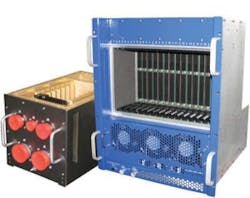Thermal and power management in airborne platforms
Power and thermal management considerations move to the forefront in the design, development, and integration of aerospace and defense electronic systems.
"Electronics are becoming more and more ubiquitous in today's military and aerospace environments," says Dan Kinney, business development manager at the Parker Aerospace Thermal Management Systems segment in Liberty Lake, Wash. Aerospace and defense systems architects and systems integrators are incorporating an ever-increasing amount of electronics into and onto today's mil-aero platforms, including aircraft, ground vehicles, ships, spacecraft and satellites, and even warfighters on the battlefield.
"Virtually everything runs on electronics these days," explains Kai Johnstad, senior product marketing manager of transportation, aerospace, and defense products at power electronics specialist Vicor Corp. in Andover, Mass. "Today, much in the military is done by computers and is very electronics-focused."
This trend, of packing current and future military and aerospace platforms with power-hungry, heat-generating electronics components and systems, is certain to continue into the foreseeable future. It also continues to drive the need for efficient and effective power and thermal management systems.
Read the rest of the article here.
